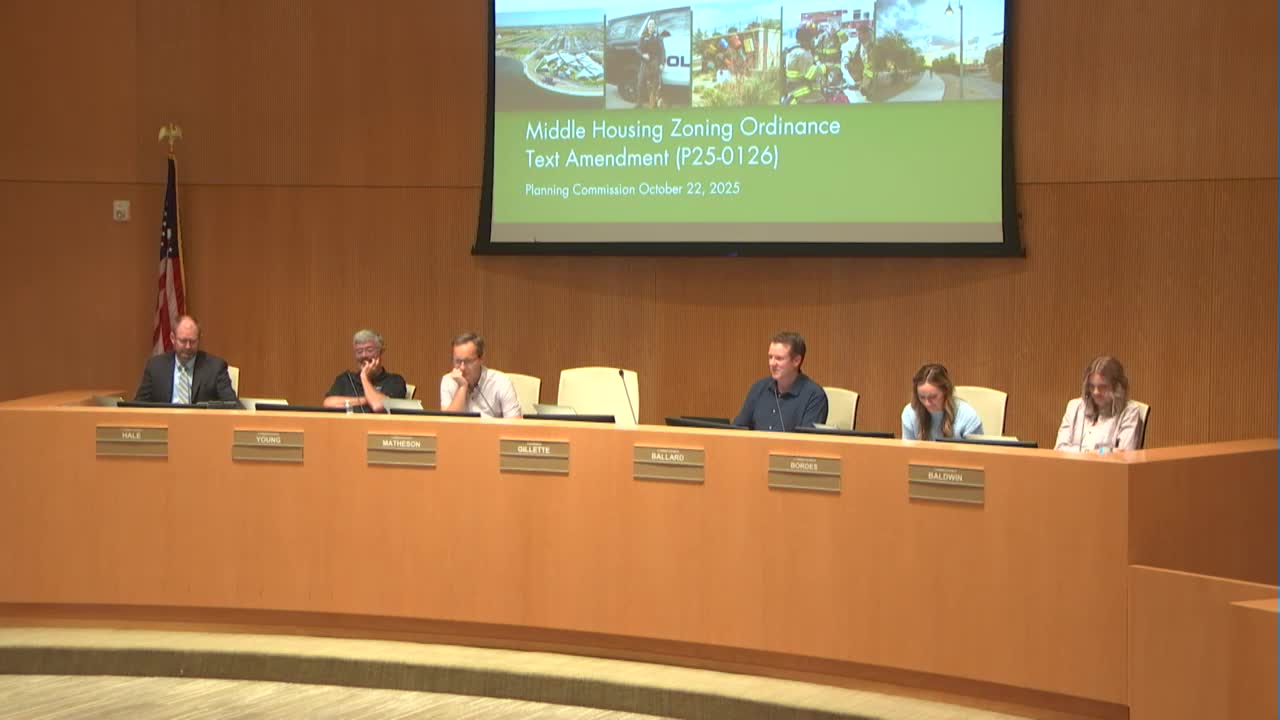Queen Creek planners adopt middle-housing zoning changes to align with state law
October 22, 2025 | Queen Creek, Maricopa County, Arizona
This article was created by AI summarizing key points discussed. AI makes mistakes, so for full details and context, please refer to the video of the full meeting. Please report any errors so we can fix them. Report an error »

Sarah Clark, principal planner for the Town of Queen Creek, told the Planning and Zoning Commission the town is adding definitions and a new section to the zoning ordinance to allow “middle housing” so the town is prepared to meet a state requirement if and when the population threshold is reached.
Clark said that “In 2024, the legislature adopted and the governor signed into law, HP 27 21, which was the middle housing bill.” The statute requires municipalities with populations of 75,000 or more to authorize duplexes, triplexes, fourplexes and townhomes on lots zoned single‑family within 1 mile of the municipality’s central business district by Jan. 1, 2026, and to allow at least 20% of any new development larger than 10 contiguous acres to include middle housing.
The change the commission approved adds definitions to the town zoning ordinance, adds middle housing as a permitted use with conditions in the permitted‑uses table and creates a new Section 4.15 (Middle Housing) that summarizes the state bill’s requirements and how the town will implement them. Clark said the town’s 2020 census population was under the 75,000 threshold and that the town expects the next census (2030) to trigger the requirement; she said the town’s approach is to adopt the ordinance now so Queen Creek will be in compliance once the threshold is reached.
Under the adopted text amendment, middle housing must conform to the development standards of the underlying single‑family zoning district (setbacks, lot coverage and height). Clark explained limits spelled out in the state law and reflected in the ordinance language: municipalities may not restrict middle housing to fewer than two floors, may not impose a floor‑area‑ratio (FAR) lower than 50%, may not require owner occupancy, may not require commercial building code or sprinklers, and may not require more than one off‑street parking space per unit. Clark said the ordinance does not change accessory dwelling unit (ADU) rules; duplex/triplex conversions require separate utilities and standalone units to qualify as middle housing.
Commissioners asked clarifying questions about when the ordinance becomes effective and how ADUs differ from middle housing. Commissioner Young and Vice Chair Ballard both confirmed their understanding that the ordinance is intended to take effect when population criteria are met and that ADUs typically remain distinct from middle‑housing units because ADUs commonly share utilities.
The commission voted unanimously to approve the ordinance text amendment (action item P5‑C). Chair David Gillette, Vice Chair Ballard, Commissioner Ashley Baldwin, Commissioner Bridal, Commissioner Hale, Commissioner Mathison and Commissioner Young voted aye; no nay votes were recorded.
Clark said staff will continue to monitor neighboring jurisdictions’ experiences and the town will track census results; if the town does not adopt regulations before Jan. 1, 2026, the statute allows middle housing on single‑family zoned lots without local limits.
The commission closed the public hearing and adopted the amendment.
Clark said that “In 2024, the legislature adopted and the governor signed into law, HP 27 21, which was the middle housing bill.” The statute requires municipalities with populations of 75,000 or more to authorize duplexes, triplexes, fourplexes and townhomes on lots zoned single‑family within 1 mile of the municipality’s central business district by Jan. 1, 2026, and to allow at least 20% of any new development larger than 10 contiguous acres to include middle housing.
The change the commission approved adds definitions to the town zoning ordinance, adds middle housing as a permitted use with conditions in the permitted‑uses table and creates a new Section 4.15 (Middle Housing) that summarizes the state bill’s requirements and how the town will implement them. Clark said the town’s 2020 census population was under the 75,000 threshold and that the town expects the next census (2030) to trigger the requirement; she said the town’s approach is to adopt the ordinance now so Queen Creek will be in compliance once the threshold is reached.
Under the adopted text amendment, middle housing must conform to the development standards of the underlying single‑family zoning district (setbacks, lot coverage and height). Clark explained limits spelled out in the state law and reflected in the ordinance language: municipalities may not restrict middle housing to fewer than two floors, may not impose a floor‑area‑ratio (FAR) lower than 50%, may not require owner occupancy, may not require commercial building code or sprinklers, and may not require more than one off‑street parking space per unit. Clark said the ordinance does not change accessory dwelling unit (ADU) rules; duplex/triplex conversions require separate utilities and standalone units to qualify as middle housing.
Commissioners asked clarifying questions about when the ordinance becomes effective and how ADUs differ from middle housing. Commissioner Young and Vice Chair Ballard both confirmed their understanding that the ordinance is intended to take effect when population criteria are met and that ADUs typically remain distinct from middle‑housing units because ADUs commonly share utilities.
The commission voted unanimously to approve the ordinance text amendment (action item P5‑C). Chair David Gillette, Vice Chair Ballard, Commissioner Ashley Baldwin, Commissioner Bridal, Commissioner Hale, Commissioner Mathison and Commissioner Young voted aye; no nay votes were recorded.
Clark said staff will continue to monitor neighboring jurisdictions’ experiences and the town will track census results; if the town does not adopt regulations before Jan. 1, 2026, the statute allows middle housing on single‑family zoned lots without local limits.
The commission closed the public hearing and adopted the amendment.
View full meeting
This article is based on a recent meeting—watch the full video and explore the complete transcript for deeper insights into the discussion.
View full meeting
